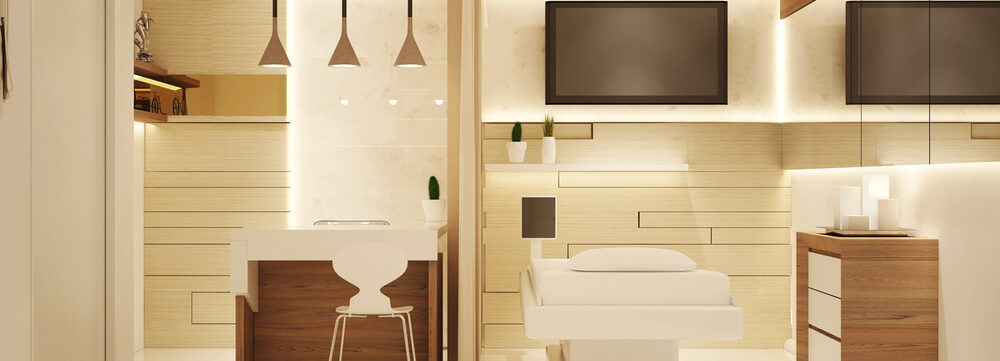Blog
Healthcare Design: Promoting Efficiency and Patient Well-Being in a Small Facility

Healthcare facilities play a critical role in providing high-quality care to patients. However, the design of these facilities is often overlooked, despite its significant impact on workflow efficiency, patient experience, and staff productivity. This is particularly important when designing small healthcare facilities, where space constraints can pose unique challenges. In this post, we will explore some healthcare design techniques used to create functional and patient-centric small healthcare facilities.
Embrace Open Floor Plans
Small healthcare facilities often face spatial limitations, making it essential to maximize the use of available space. One effective technique is to adopt open floor plans, which promote flexibility, enable efficient workflow, and create a welcoming environment. By removing unnecessary walls and dividing spaces using movable partitions, healthcare facilities can create areas for patient consultations, exams, and other medical services, adapting to their needs. Healthcare Design Techniques That Create a Welcoming Atmosphere
Efficient Patient Flow
Efficient patient flow is crucial in any healthcare facility, especially in small ones where space is at a premium. Designers must carefully plan the layout, ensuring logical and intuitive pathways for patients, staff, and supplies. Entryways and exits should be clearly labeled, facilitating smooth movement throughout the facility. Additionally, grouping related facilities, such as exam rooms and nursing stations, can minimize travel time and enhance workflow efficiency. Creative Wayfinding Techniques That Healthcare Designers Can Use to Improve Patient Experience
Aesthetic Considerations
Small healthcare facilities need not sacrifice aesthetics for practicality. Incorporating soothing colors, natural light, and comfortable furnishings can contribute to a calming and healing environment. Strategic placement of windows allows for a connection to nature while aiding in creating well-lit spaces. Including artwork and greenery can also promote a positive ambiance, reducing anxiety and stress for patients and staff. Sky Factory Creates Illusions of Nature to Promote Healing and Well-being
Smart Storage Solutions
Storage is often a challenge in small healthcare facilities, but careful consideration can provide creative solutions. Utilizing vertical space with tall cabinets or shelves is an efficient way to maximize storage capacity. Custom-designed storage units can optimize specific medical supplies and equipment, allowing for quick and easy access while keeping the facility organized and clutter-free. The Importance of Wipeable Materials in the Healthcare Setting
Technology Integration
Incorporating advanced technologies can significantly enhance the efficiency and effectiveness of small healthcare facilities. Digitizing patient records, scheduling systems, and medical equipment can streamline processes and minimize human error. Telemedicine capabilities can also be integrated, allowing patients to have consultations without physically being present in the facility, thus expanding access and reducing wait times. Optimizing Efficiency in Healthcare Design with Occupancy Sensors
Promoting Privacy and Comfort
Creating private spaces for patient consultations and examinations is crucial for maintaining confidentiality and providing personalized care. Designers should provide soundproof walls, acoustic treatments, and adequate insulation to minimize noise disruptions. Additionally, ensuring comfortable seating arrangements, intimate waiting areas, and creating privacy through smart layout design all contribute to patient comfort and overall satisfaction. Enhancing Healthcare Design with Room Temperature Controls: A Boost to the Patient Experience
Promoting Efficiency and Patient Well-Being in a Small Facility
Designing small healthcare facilities requires a careful balance between space optimization, operational efficiency, and patient-centricity. By embracing open floor plans, efficient patient flow, aesthetic considerations, smart storage solutions, technology integration, and promoting privacy and comfort, healthcare designers can create small facilities that are functional, welcoming, and optimize patient care.
Moreover, these design techniques are not only applicable to small facilities but can also be utilized to enhance larger healthcare establishments. As we continue to witness advancements in healthcare design, ensuring patient-centered spaces is increasingly seen as a key driver for improved healthcare delivery. With thoughtful design, small healthcare facilities can provide exceptional healthcare experiences, fostering healing and well-being for all who pass through their doors. Designing the Perfect Healthcare Experience: Techniques for an Outstanding First Impression
Marie Wikoff is the creator of Wikoff Design Studio based out of Reno, Nevada. Her expertise in healthcare design has helped modernize healthcare organizations locally, regionally, and internationally, improving patient experience and outcomes. Her credentials include Evidence-Based Design Accreditation and Certification (EDAC), American Academy of Healthcare Interior Designer (CHID), the National Council of Interior Design Qualification (NCIDQ) and LEED AP. Contact Marie Wikoff







